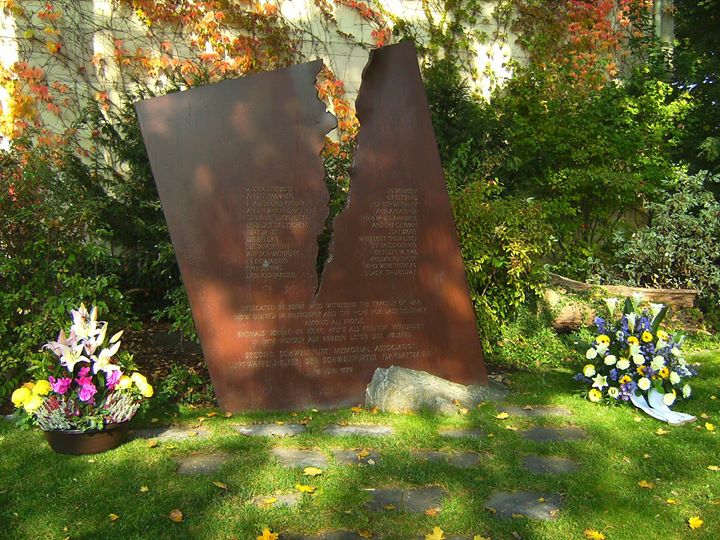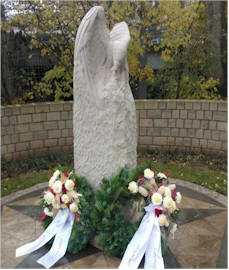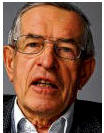
 |
|
|
THE HIDDEN HEROES AFTER-WAR MEMORIAL AT TALLY HO
FARM WINKFIELD SL4 4RZ ENGLAND |
| How Schweinfurt gives thanks for foes become friends | |



 |
| Three forms of reconciliation between communities and nations | ||
|
BEFRIENDING
FLY2HELP & ROSIE
SCHWEINFURT RECONCILED 1943-2014
|
A total of 2,285
Allied planes dropped 600,000 bombs weighing
nearly 8,000 tons.
Production was never permanently interrupted, despite the attacks, and eventually levelled off at 85 percent of pre-war production.
Schweinfurt, however, was badly shaken. The air raids destroyed half of civil buildings and industrial facilities.
|


OUR CARTRIDGES SEEN IN EARTH FROM SCHWEINFURT SENT BY PASTOR DIETER SCHORN OF THE LUTHERAN CHURCHES. DIETER HAS BEEN A GREAT FRIEND OF THE SECOND SCHWEINFURT MEMORIAL ASSOCIATION, AND HAS ALSO OVERSEE MUCH OF THE FINE WORK OF RECONCILIATION BETWEEN THE CITY AND THE GARRISON. HE WAS THERE ON 14 OCTOBER 1943. 
 MICHAEL PFRANG, PASTORAL WORKER IN THE CATHOLIC PARISH OF ST JOSEF, AND SOME BALLBEARINGS OF THE FAG BRAND MADE BY SCHAEFFLER IN SCHWEINFURT. THEY ARE RESTING ON EARTH FROM ST JOSEF'S. THE ORGINAL CHURCH WAS DESTROYED IN THE BOMBING ON 14 OCTOBER 1943, THE PARISH PRIEST AND TWO CHILDREN WERE KILLED. MICHAEL IS SEEN HOLDING AN SSMA PIN AT A SMALL HANDOVER CEREMONY AT ST MARTIN'S IN THE FIELD CHURCH IN CENTRAL LONDON IN APRIL 2014 - WHEN HUGH GIBBONS PRESENTED HIM WITH SOME SOIL FROM ST JOSEPH'S CHURCH IN BRACKNELL, AND A $1 NOTE AS A TOKEN TOWARDS ST JOSEF'S FUNDS. |
|
|
||
| "...in the hope for lasting peace among all people" | ||
|
Thirty years after the Second Schweinfurt Raid, some of the survivors from the Mighty 8th Air Force, including Colonel Budd Peaslee, S/Sgt Phillip Taylor and 1st Lt William Allen, decided to form an organization to commemorate their fallen comrades-in-arms.
They called it
the Second
Initially, the full members of this association
were all veterans of the 8th Air Force who flew
on Mission 115. Every year the members, and
their families and friends, meet in a different
city in the United States around the 14th of
October to honor their dead fellow airmen.
However, at the 50th
Anniversary in 1993, two Germans - Dr. Helmut Katzenberger and Vomar Wilckens
- came to the
reunion in New Orleans to present to the group
information they had on that fateful day.
In 1996 Georg Schafer contacted the SSMA and
asked to join the organization.
He came to the reunion in Las Vegas and brought
many artefacts from "Black Thursday". Many of
these artefacts are permanently included in the
Second Schweinfurt display at the Mighty 8th Air
Force Museum in Savannah, Georgia.
It was at this reunion that the Americans suggested erecting a joint memorial remembering this mission. Mr. Schafer presented this idea to his fellow Luftwaffenhelfers, who embraced the idea.
On June 16, 1998 a German American
Memorial was dedicated by members of SSMA,
former Luftwaffenhelfers and the city of
Schweinfurt on a site alongside the former
“Spitalsee” air raid shelter in Schweinfurt. The
memorial was created by G. Hubert Neidhard
(3/3/28 - 5/14/99), who was an art teacher at
Alexander von Humboldt High School in
Schweinfurt and a flak-helper in his hometown
during the war.
This started the amicable meetings between
members of the SSMA and the former flak helpers.
In 1999, a group of former flak helpers,
accompanied by Gudrun Grieser, Lord Mayor of the
City of Schweinfurt, attended the reunion in
Savannah, Georgia.
Reno, Nevada was the site of the 2000 Reunion.
In 2001, SSMA decided to hold their reunion in
Schweinfurt, the first time the organization had
held their meeting outside of the U.S. Sixty two
participants from the U.S. attended despite the
disastrous events in New York and Washington on
September 11. Fort Worth was the site of the
2002 Reunion, Seattle in 2003. In 2004 and 2007
the members returned to meet in Schweinfurt.
The bonding between former enemies is an impressive sign of active reconciliation, but also an admonition to future generations to do all they can so that horrors like those in the 20th century are never repeated.
The inscription
on the German American Memorial speaks to the
bond between these two groups: "Dedicated by
some who witnessed the tragedy of war, now
united in friendship and the hope for lasting
peace among all people". |
 The German American Memorial at Spitalsee-Bunker IN MEMORY OF SCHWEINFURT AND AIRMEN OF THE 8th US AIRFORCE ANS THE GERMAN LUFTWAFFE WHO LOST THEIR LIVES ON MISION 115, OCTOBER 14 1943, KNOWN TO THOSE WHO WERE THERE AS BLACK THURSDAY. DEDICATED BY SOME WHO WITNESSED THE TRAGEDY OF WAR NOW UNITED IN FRIENDSHIP AND THE HOPE FOR LASTING PEACE AMONG PEOPLE SECOND SCHWEINFURT MEMORIAL ASSOCIATION LUFTWAFFENHELDER DE SCHWEINFURTER FLAKBATTERIEN The designer G Hubert Neidhart (1928-99) noted that "the rust-coloured rectangular heavy steel slab has come out of plumb. Declining obliquely, it plunges down into the ground, thereby splitting an erratic boulder. Under enormous pressure of this violent impact from above, the boulder is slashed, bent and torn open. A deep, gaping gash has been inflicted upon it. The deep cleft remains open, visible for all times, showing serious injury, a wound not yet healed...The inscription, however, contrasts this unbalanced image. It is an appeal to remember, to commemorate, to reflect - a reminder, a request for more humanity." "The Memorial is not a glorification of war, not an appeal for hero-worship, but simply a quiet, modest warning reminding us of a fateful past.  The Winkfield B17's cartridges reconciled with some of the soil from the Memorial, sent by the Lutheran churches of the city in March 2014. The nearest they'd been before was about 4 miles away on 14 October 1943 |
|
| A salute to Schweinfurt by those leaving | ||
|
Directive JCS 1067, which went into effect April 1945, mandated that Germany had to be treated as defeated enemy state. Any type of “fraternization” with the German population was prohibited. The directive was only valid until July 1947.
German-American relations grew and
strengthened over the course of decades.
Americans obliged Germans with “goodwill”
gestures. American officers’ wives, for example,
invited German high school students for tea.
U.S. Army units bought Christmas gifts for
children in 1946. Finally the Americans became a
part of the cityscape: They had German
landlords, ate in German restaurants, became
friends or made acquaintances with Germans.
There were various joint events such
as the German-American Volksfest, which used to
take place in an area in Ledward Barracks.
However, after
11 September 2001, the event was
relocated to the grass area behind the bowling center on Kessler Field. In addition, Americans
became members in German clubs such as the
German-American Wanderclub Schweinfurt e.V., a
hiking club.
|
 A TRIBUTE TO THE COMMUNITIES LIVING AND WORKING TOGETHEROVER THE DECADES SEEN HERE ON THE GARRISON WEBSITE |
|
| The all-inclusive Schweinfurt Soldiers’ and Veterans’ Monument that's staying | ||
|
This monument commemorates and celebrates all
the trials and jubilations of the past seven
decades.
As a lasting monument to the time and service
given by soldiers and their families to both the
Army and the greater community, in 2012 the was
dedicated in the Alter Friedhof – a public park
situated behind the Schweinfurt Musikschule on
the Gutterman Promenade, and a location
accessible to all. The monument is the work of
local artists Steff Bauer and Sören Ernst
One major aspect of the monument is its
inclusiveness. It stands as a testament to every
U.S. Armed Service Member who has served in
Schweinfurt since the end of World War II.
It is a
symbol of their service, commitment, sacrifice
and the partnership that they have helped to
forge between the American military community
and their German hosts.
The monument consists of a sculpture of a bald
eagle at rest placed upon a terrace that
incorporates the national symbol of the five
pointed star. The
star is also symbolic of peace and harmony —
important themes in German-American relations.
Framing the sculpture is a low wall that ideally
places the monument in its own contemplative
setting.
The eagle has a triple meaning of being the symbol of not only the United States of America, but also the city of Schweinfurt and the Republic of Germany. The eagle is not in the typical pose of triumphant flight, but is rather at rest. It is symbolic of the peaceful relationship our two nations have enjoyed since 1945. It also demonstrates that even a warrior must take time to rest and contemplate what he has done and what he will do in the future.
The statue, wall and terrace are all in the
native material of sandstone that has been
specially treated to withstand the rigours of
time. Because the monument will be in a public
park, it will be maintained by the city, and is,
therefore, a fitting and lasting tribute.
This project was spearheaded and primarily
financed by the Veterans of Foreign Wars and
Ladies Auxiliary. |
  |
|
| Nations helping nations - thanksgiving in the streets and fields of Schweinfurt | ||
|
IN LATE 2013, the city of Schweinfurt arranged an exhibition to mark the 70th anniversary of the Second Schweinfurt raid.
As part of this, a very fine catalogue was produced by the team at the Stadtsarchivs in the city; overseen by Uwe Muller with contributions by Hans-Peter Baum and Daniela Kuhnel.
In German and English, Schweinfurt in the Air War 1943-1945 is a superb and definitive guide to the history of the 14 air raids that the city suffered. It has many photographs.
The commentary by the eminent historian Hans-Peter Baum looks at all sides of the story.
But it includes five perspectives about those on the ground that are hidden from many other accounts - yet have historical importance.
|
   FLAKHELFER GEORGE SCHAFER AT SCHOOL IN 1942 - AND AT A SECOND SCHWEINFURT MEMORIAL ASSOCIATION REUNION  |
|
|
BEFRIENDING
FLY2HELP & ROSIE
SCHWEINFURT RECONCILED 1943-2014
|
|
|